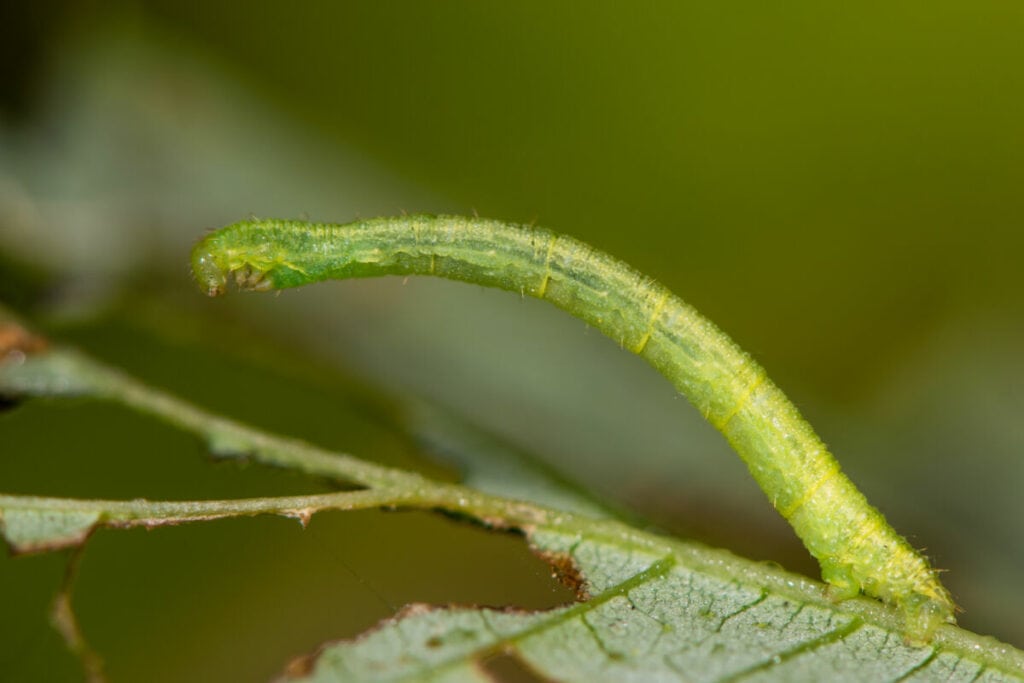Looper infestations can harm vegetables, act fast if you think you have one.
We’ll discuss how to identify loopers, ways to prevent them from taking over your garden, and how to control an existing infestation. So let’s get started!
What are loopers?
Loopers are small, green caterpillars that feed on vegetable plants. They move in a looping motion and have three pairs of legs near their head.
What damage do loopers cause on plants?
Loopers cause significant damage to vegetable plants by consuming the leaves and stems of the plant. They are especially fond of eating young, tender leaves, which can lead to wilting or yellowing of foliage.
Loopers have been known to strip a plant bare of its leaves, leaving only the stems behind. In extreme cases, they can even eat through entire stalks and fruit bodies.
The presence of loopers also increases the risk of disease transmission to susceptible plants as they travel from one plant to another looking for food.
How to identify loopers on plants

Loopers can be identified by their small, green caterpillar shape and the looping motion they make as they crawl.
Loopers have three pairs of legs near their head, with each pair being a different color. Loopers leave behind a trail of dark excrement, known as frass, which can help you identify if your plants are infested.
Another way to tell if your plants have been invaded by loopers is to look for signs of leaf damage. Loopers will often consume whole leaves or take bites out of them, leaving behind what looks like “windows” in the foliage.
Read more:
How to get rid of loopers
Hand-pick the loopers off of the plants and dispose of them away from your garden.
Spray insecticidal soap directly onto the loopers to kill them instantly.
Use diatomaceous earth on the plants to help get rid of the loopers.
Apply a biological control such as Bacillus thuringiensis (Bt) or spinosad to kill the loopers.
Read more:
- How To Stop Insects Eating Plant Leaves
- How to Use Neem Oil and Save Your Plants
- How To Use Diatomaceous Earth In Potted Plants
- Insecticidal Soap vs Dish Soap for Pest Control
How to prevent loopers on plants
Remove any infested plants immediately to prevent further spread of the loopers.
Use row covers on your vegetables to help prevent looper infestations.
Attract natural predators like birds, wasps, lacewings, and nematodes to your garden to help keep the population of loopers down.
Avoid using synthetic fertilizers or insecticides on your vegetables as these can kill off natural predators and attract loopers instead of deterring them from invading your garden
Host vegetable plants for loopers
Vegetable plants, such as broccoli, cabbage, kale, lettuce, and cauliflower, are all susceptible to loopers.
Natural predators of loopers
These include birds, wasps, lacewings, ladybugs, nematodes, and parasitic flies. Birds such as sparrows and chickadees feed on loopers, while wasps and lacewings can paralyze them with their sting and then lay their eggs on them for their young to feed.
Ladybugs will often eat the eggs of loopers before they hatch. Nematodes are microscopic worms that attack the larval stage of loopers by entering through their body wall.
Finally, parasitic flies will lay their eggs inside the looper’s body- when these hatch they will feed on the looper from within until it dies.
References
- https://ipm.ucanr.edu/agriculture/cole-crops/cabbage-looper/
- https://entnemdept.ufl.edu/creatures/veg/leaf/cabbage_looper.htm
- https://www.missouribotanicalgarden.org/gardens-gardening/your-garden/help-for-the-home-gardener/advice-tips-resources/pests-and-problems/insects/caterpillars/cabbage-looper

Fact Checked, Written, and Published by Kevin Rodrigues
Kevin is the founder of Gardening Mentor, a website that aims to teach people to grow their own food in a limited space. As a self-taught gardener, Kevin has spent several years growing plants and creating gardening content on the website. He is certified in Home Horticulture and Organic Gardening from Oregon State University. He has a Post Graduate Diploma in Horticulture and Landscape Gardening from Mumbai University.
Read more
